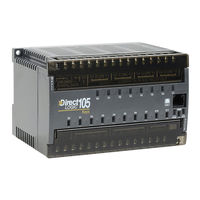
AutomationDirect DL105 Manuals
Manuals and User Guides for AutomationDirect DL105. We have 2 AutomationDirect DL105 manuals available for free PDF download: User Manual
AutomationDirect DL105 User Manual (372 pages)
Brand: AutomationDirect
|
Category: Controller
|
Size: 18 MB
Table of Contents
-
Introduction23
-
Enclosures42
-
Introduction91
-
Default Mode93
-
Purpose95
-
Purpose106
-
Wiring Diagram107
-
Select Mode110
-
Wiring Diagram114
-
Velocity Profile117
-
Set Velocity129
-
Start Profile129
-
Purpose137
-
Main Program139
-
Purpose140
-
Introduction144
-
CPU Modes148
-
Using a Password152
-
Program Mode154
-
Run Mode154
-
Read Inputs155
-
Write Outputs156
-
Diagnostics156
-
Reading Inputs160
-
Writing Outputs160
-
PLC Resources162
-
V- Memory163
-
Memory Map164
-
Default Values169
-
DL105 Aliases170
-
DL105 Memory Map171
-
Input Bit Map172
-
Y Output Bit Map172
-
Introduction176
-
END Statement178
-
Simple Rungs178
-
MID-Line Outputs179
-
Boolean Stack181
-
Store Not (STRN)183
-
Or Store (ORSTR)186
-
Pause (PAUSE)191
-
Using Timers203
-
Using Counters208
-
Counter (CNT)209
-
Using Pointers220
-
Load (LD)221
-
Or Double (ORD)232
-
Compare (CMP)235
-
Subtract (SUB)239
-
Multiply (MUL)241
-
Encode (ENCO)246
-
Decode (DECO)247
-
MLS/MLR Example256
-
Interrupt (INT)257
-
Fault (FAULT)259
-
Fault Example260
-
Introduction264
-
Drum Terminology264
-
Step Transitions266
-
RLL Equivalent282
-
Stage Equivalent282
-
Let's Compare283
-
Stage Counter295
-
Diagnostics304
-
Non-Fatal Errors304
-
PWR Indicator308
-
Run Indicator309
-
Some Quick Steps310
-
Run Time Edits316
Advertisement
AutomationDirect DL105 User Manual (350 pages)
Micro PLC
Brand: AutomationDirect
|
Category: Controller
|
Size: 8 MB
Table of Contents
-
-
Introduction20
-
-
-
Enclosures38
-
-
Introduction77
-
Default Mode80
-
Purpose82
-
Purpose93
-
Purpose99
-
Wiring Diagram101
-
Velocity Profile105
-
Purpose119
-
Purpose124
-
Purpose127
-
-
-
Introduction130
-
CPU Modes135
-
Using a Password139
-
CPU Operation140
-
Program Mode141
-
Run Mode141
-
Read Inputs143
-
Write Outputs143
-
Diagnostics143
-
Reading Inputs147
-
Writing Outputs147
-
PLC Resources149
-
Memory150
-
Memory Map151
-
DL105 Aliases157
-
DL105 Memory Map158
-
Input Bit Map159
-
Y Output Bit Map159
-
-
-
Introduction162
-
END Statement163
-
Simple Rungs163
-
Midline Outputs164
-
Boolean Stack167
-
Store (STR)169
-
Store Not (STRN)169
-
Or (OR)170
-
Or Not (ORN)170
-
And (AND)171
-
And Not (ANDN)171
-
Out (OUT)174
-
Or out (or OUT)174
-
Set (SET)175
-
Reset (RST)175
-
Pause (PAUSE)176
-
Store (STR)180
-
Store Not (STRN)180
-
Or Not (ORN)181
-
And (AND)182
-
And Not (ANDN)182
-
Using Timers187
-
Using Counters192
-
Counter (CNT)193
-
Using Pointers203
-
Load (LD)205
-
Out (OUT)209
-
Pop (POP)210
-
And (AND)212
-
Or (OR)214
-
Or Double (ORD)215
-
Compare (CMP)218
-
Add (ADD)220
-
Subtract (SUB)222
-
Multiply (MUL)224
-
Divide (DIV)225
-
Encode (ENCO)229
-
Decode (DECO)230
-
Binary (BIN)231
-
Invert (INV)233
-
Move (MOV)234
-
End (END)237
-
Stop (STOP)237
-
MLS/MLR Example239
-
Interrupt (INT)240
-
Fault (FAULT)243
-
Fault Example243
-
-
-
Introduction246
-
Purpose247
-
Drum Terminology247
-
Output Sequences248
-
Drum Instruction257
-
-
Chapter 7: RLL
262-
RLL Equivalent265
-
Stage Equivalent265
-
Let's Compare266
-
Initial Stages266
-
Stage Counter278
-
Stage (SG)280
-
Jump (Jmp)281
-
-
Introduction300
-
AUX 83 Lock CPU307
-

